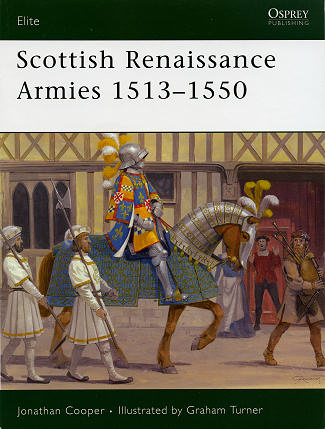 This
time period was an odd one in many ways. The Scottish armies that faced those of
England lost every major battle in which they fought. Yet the result was that
they won the war.
This
time period was an odd one in many ways. The Scottish armies that faced those of
England lost every major battle in which they fought. Yet the result was that
they won the war. Osprey's Scottish Renaissance Armies 1513-1550
|
Author: |
Jonathan Cooper, illustrated by Graham Turner |
|
Publisher/Distributor |
Osprey Publishing |
|
Price |
$18.95 |
|
Reviewer: |
|
| Notes: |
64 pages, 7¼ x 9¼
inches, softbound ISBN: 978-1-84603-325-4 |
 This
time period was an odd one in many ways. The Scottish armies that faced those of
England lost every major battle in which they fought. Yet the result was that
they won the war.
This
time period was an odd one in many ways. The Scottish armies that faced those of
England lost every major battle in which they fought. Yet the result was that
they won the war.
As many of you know, during this time period in history, there was no standing national army. Each of the various kings and lords of a land may have had a small band of permanent troops (more like thugs than anything else) to help to keep control over the countryside. If more men were needed, then the various smaller aristocracy and landed gentry were expected to provide soldiers. It was also quite common to hire mercenary troops from outside the country to come an do battle for you; for a price.
There has seemingly been a pretty much constant battle between English and Scottish kings during these times as well as a lot of petty squabbling and warfare within Scotland between rival clans. From time to time there were strong kings on the throne and sometimes enlightened ones. One of the latter and even partly former was James IV, a true Renaissance king who embraced literature and the sciences and a variety of disciplines during his too-short reign. He was also quite fond of military equipment and power and tried to build up both a national army and a fleet with some success on both tasks. He was also a friend of England's long-time enemy, France. Many of the battles of the time were with the aid of the French, either in terms of equipment, manpower or both.
In this particular volume of Osprey's 'Elite' series, we have a look at how these battles were fought. Particularly we start out with several battles and campaigns to see how the Scots managed to do in these situations and some of the errors and successes they had. With that established, the book then goes into how the armies were formed and how they were organized (if that term could be used). Then a large section on the tactics that were used in the field and how these changed over the years. Then comes a major section in the book that covers the arms and equipment used by these units. This includes the various banners and colors of the various units involved. The book then ends with a section on the importance of Franco-Scottish collaboration during this time period.
This is all ably illustrated by Graham Turner and a goodly selection of maps and battle plans. There are also a well chosen number of period artwork pieces and artifacts to further add to the book.
I have to say that I went into this one with a 'ho-hum' and was quickly drawn into the book. It ended up being a very interesting look at a subject and time period about which I knew little. I think that you will also find this one to be of great interest.
January 2009
For more on the complete line of Osprey books, visit www.ospreypublishing.com. In the US, it is Osprey Direct at 44-02 23rd St, Suite 219, Long Island City, NY 11101., where you can get a catalogue of available books.
If you would like your product reviewed fairly and quickly, please contact me or see other details in the Note to Contributors.